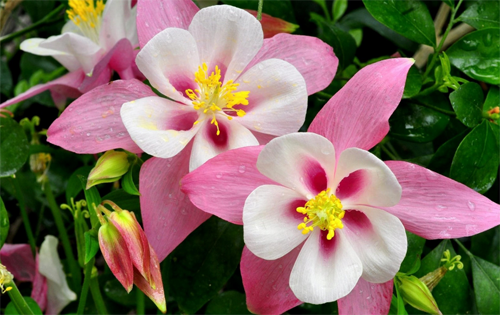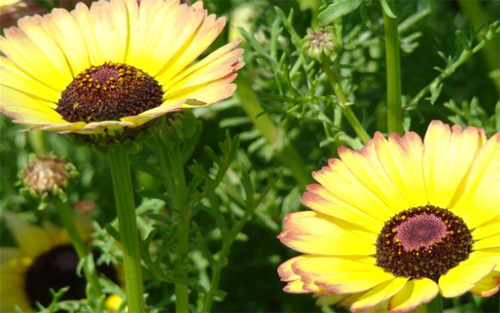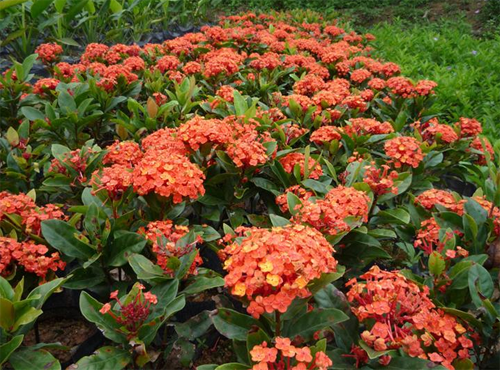What is the planting method and propagation price of Douzi?
The flowers of Euphorbia angustifolia are very beautiful, and there are small tentacles behind them. When they move, they are really super cute. What is the planting method of Euphorbia angustifolia? How do you reproduce? How much is it for each plant?

Planting method of Euphorbia angustifolia
The flowers are petite and exquisite, with bright colors and strong adaptability, which should be planted on the lawn and under the sparse forest. in spring, the grass is full of small yellow flowers, full of wild interest, and should also be covered in wet places such as depressions and streams. Natural planting, flower border, flower bed, rock garden. Fine garden flowers, leaves and flowers are beautiful.
The peanut is strong, cold-resistant and likes a cool climate; it likes fertile, moist, humus-rich and well-drained soil.
Like higher air humidity, summer should be maintained under semi-overcast conditions, can not be exposed to the sun, the growing period to keep the basin soil slightly moist, not stagnant water on the line.
The mode of reproduction of Rabdosia oleifera:
Generally, the method of sowing and plant division is adopted to propagate.
It is best to plant seeds in pots immediately after the seeds are ripe. Sowing seeds should be sparse. Before emergence, sowing pots should be covered with glass to keep the soil moist and shaded. The seedlings emerged after 1 month. The seedlings blossom the following year.
The excellent varieties of Euphorbia angustifolia are usually carried out in March-April or August-September, but it is better in autumn.
The seedlings of Euphorbia angustifolia can be planted at about 10cm, and the row spacing is 30~40cm.
Topdressing should be applied before flowering.
Shade is needed in summer. Cold areas need to be slightly covered in winter. The plant is easy to decline after 3 years, so it should be divided in time to promote its renewal.
Brief introduction to Doucai:
Aliases: blood sorrow, cat claw flower, condor flower
It has many colors and varieties, usually five petals, a little shorter than the calyx, so it looks very lovely and beautiful.
The height of the plant is 50-70 cm. The stem is erect, double and Ternate, blue-green (similar to the leaf shape of many ferns).
Corolla funnel-shaped, pendulous, petals 5, usually dark blue-purple or white, cultivated varieties have pink, yellow and other colors; sepals 5, the same color as petals. The fruit is dark brown.
This is the end of the introduction to the planting method of Euphorbia angustifolia. What is the price of Euphorbia oleifera?
Doucai is not available in every place where you buy flowers. Sometimes you can encounter it. The price is about 10 yuan per pot, and the pot is relatively common. It's really easy to raise and die when it's indoors, so I raised one plant. It's still a little sad.
Propagation methods of Rabdosia angustifolia
Ipomoea angustifolia likes cool climate and avoids high temperature exposure in summer. It is suitable for growing in sandy loam. Strong and hardy, like sandy loam rich in humus, moist and well drained. Ramet or sowing propagation, sowing and reproduction can be carried out in spring and autumn.
It is necessary to apply sufficient basic fertilizer before planting, and it is relatively dry in spring in the north, so it should be watered 4 or 5 times a month (according to the environment, the dry humidity of the basin soil should be appropriately increased or decreased), shaded properly in summer, or planted in a semi-shaded place, the growth is more exuberant, stagnant water is avoided, and drainage should be done in time after rain. Strictly prevent lodging and strengthen pruning to facilitate ventilation and light transmission.
When the seedling grows to a fixed height (about 40 cm), it is necessary to pick the heart in time to control the height of the plant; after winter, it is necessary to apply sufficient base fertilizer, and in the northern region, enough antifreeze water should be poured and soil should be cultivated at the base of the plant to improve the anti-freezing energy of overwintering.
Euphorbia angustifolia is often propagated by sowing or dividing plants.
Sowing in spring and autumn, sowing seedlings can blossom in about 2 years. The colonized seedlings need to be renewed for 3 ~ 4 years. Cold-resistant, strong growth, like wet and well-drained sandy loam. It is better to grow in semi-shade. Ramet should be carried out before germination or after defoliation in early spring. Sowing is better than potting immediately after the seed is ripe.
Sowing and reproduction: sowing seeds should be sparse. Cover the sowing pot with glass before emergence to keep the soil moist and shaded. The seedlings emerged after 1 month. The seedlings blossom the following year. The superior varieties usually adopt the method of plant separation, which is carried out in March-April or August-September, but it is better in autumn. The seedlings can be planted about 10 cm, and the row spacing is 30cm to 40cm. Topdressing should be applied once before flowering. Shade is needed in summer. Cold areas need to be slightly covered in winter. The plant is easy to decline after 3 years, so it should be divided in time to promote its renewal.
Branch propagation: fertilization and soil preparation are the same as above. Planting in spring and autumn, from January to April in spring and from August to December in autumn, the row spacing is 10 × 13.2 cm, cover soil 1.6 cm, pour enough water to fix roots, and keep the soil moist during growth. During the peak growth period, a small amount of urea was applied and irrigated with 5 kg urea and water per mu to promote growth. Seed propagation: it can be sown with seeds from January to April in spring and from June to December in autumn.
Apply sufficient base fertilizer, rake fine and flat, make the seedbed, pour enough bottom water, sow the seeds evenly on the seedbed, cover with concrete soil to see the seeds. Keep the border moist, excessive humidity will cause rotten seeds, and seedlings will emerge in 140 days. Such as covering seedlings with film for 60 days. Ventilation after seedling emergence, seedling height 6.6 cm transplanting in the field, along with digging, plant spacing of 10 × 13.2 cm, after survival, topdressing.
Planting methods and matters needing attention of potted Buckeye
If you have seen the appearance of Doucai, I believe it will be attracted by its unique beauty. Rabdosia angustifolia occupies a high position in medicine in China, and its ornamental value is not inferior to that of other flowers and plants. The flowering potted cabbage is very beautiful and unique, so it is suitable for viewing, so it is a good choice for family potted plants.
How to raise Chinese cabbage
1. Upper basin
After 5 to 6 weeks of germination, 3-4 cm diameter hole plates can be used for transplantation. after 5 to 6 weeks, blue flowers can be transplanted into pots with 10-15 cm flowerpots, fan-shaped ones can be transplanted into pots with 7-11 cm flowerpots, and hybrids can be transplanted into pots with 11-16 cm flowerpots. Twice transplanting is beneficial to the quality of the plant.
2. Media
The soil content in the substrate is about 15%. About 15% organic matter (such as wood fiber and bark) can be added, and 1 to 1.5kg of fully balanced fertilizer and 1 to 2kg of slow-release fertilizer, iron chelate and micronutrient elements should be added to each cubic meter of substrate. The pH value should be between 5.5 and 6.2.
3. Lighting
A medium-and long-sunshine plant of the genus Euphorbia. Maintain the highlight level. Potted varieties need to replenish light in winter and spring, which is helpful to improve the quality of plants. In the middle of January, it needs to grow under long sunshine (16 hours) and continuous supplementary light (30000 to 40000 lux), and the temperature is kept at 12 ℃.
4. Temperature
The suitable temperature for growth and development is from 14 ℃ to 16 ℃. After root formation, the temperature decreased to 8 ℃ to 10 ℃. The change of temperature can improve the quality of plants. In spring, seedlings begin to grow at a temperature of 15 ℃ to 18 ℃ for 6 to 7 weeks. The temperature of 10 ℃ to 12 ℃ will prolong the cultivation time. Avoid high temperature and weak light conditions.
5. Fertilization
The amount of fertilizer needed is moderate, and the balanced fertilizer of nitrogen and potassium with the concentration of 130ppm to 150ppm can be sprayed once a week. Avoid high ammonium and nitrogen levels. No fertilizer can be applied after mid-September.
Planting methods and points for attention of potted Rabdosia angustifolia
1. Planting method of potted Rabdosia angustifolia
1. Selection of basin soil
For potted plants, you need to choose a slightly larger flowerpot and put the soil in the flowerpot, which can be sandy soil with good drainage or humus-rich saprophytic soil, and a little base fertilizer should be added to the soil.
2. Light and temperature
Douzi likes a cool climate, avoid high temperature but can be cold-resistant, and need to keep enough light. It is necessary to maintain the growth temperature between 15 ℃ and 35 ℃, with moderate light to avoid high temperature and sun exposure in summer, when shading is needed, or the potted plants should be kept in a semi-shaded place.
3. Watering and fertilizing
Euphorbia angustifolia needs to strengthen the management of reasonable watering and fertilization. In the peak period of growth, we need to give sufficient water, according to the degree of dryness and wetness of the basin soil to determine the amount and times of watering, but avoid stagnant water. Dry weather needs timely drainage, and after rain, it needs timely drainage, pay attention to maintain a certain amount of air humidity. Fertilization requires medium fertility. Fertilizer can be applied once a week, but the concentration should not be too high. Pay attention to stop fertilizing after autumn, in addition, you need to apply some phosphate and potash fertilizer before flowering to make the flowering more gorgeous.
2. Matters needing attention in the culture of Rabdosia angustifolia
1. Methods of reproduction
Basically, it is propagated by ramet or sowing, which can be sowed in spring or autumn, and ramet reproduction is mainly in autumn.
2. Pick the heart
During the growth period, it is necessary to pick the heart in time to control the height of the plant. After blooming, the remnant flowers can be cut off, so that it can be preserved as a foliage plant.
3. Diseases and insect pests
The main pests are aphids, which can cause mosaic disease and powdery mildew, which need timely and reasonable treatment.
How to reproduce Ipomoea oleifera
1. Sowing: sowing is better than pot sowing immediately after the seeds are ripe. In order to adjust the dormancy period, the seeds are sown immediately after harvest. Apply sufficient base fertilizer, rake fine and flat, make the seedbed, pour enough bottom water, sow the seeds evenly on the seedbed, cover with concrete soil to see the seeds. Keep the border moist, excessive humidity will cause rotten seeds, and seedlings will emerge in 140 days.
2. Ramet: the ramet is carried out from August to September, first cut off the upper branches and leaves of the plant, retain the lower sprouts of the growing point, then dig up the plant, shake off the soil, and plant it separately according to the main root. If the main root is senescent, it should be removed to make sure that there is a part of the root neck at the base of the bud, then cut it on the sand bed and plant it separately after taking root, so that the cuttings can blossom in the second year.
What to do with cauliflower mosaic disease
1. Symptoms
The disease occurred in the whole plant, with foliar shrinkage and deformity. The pathogen is caused by cucumber mosaic virus. The virus is spherical in diameter, 35 nm in diameter, the detoxification temperature is 60-70 ℃, and the in vitro preservation period is 3-5 days. There is a wide range of hosts. The route of transmission may be transmitted by friction between aphids and juices, causing disease-free and healthy plants to occur.
2. Prevention and control methods
Scientific and effective fertilization, more use of compound fertilizer, organic fertilizer, avoid partial application of nitrogen fertilizer, plus phosphorus and potassium fertilizer, so as to improve the nutritional conditions, improve the anti-virus ability of the plant, and timely loosen the soil and promote the root development of the plant. Get rid of weeds in time. Early prevention and control of aphids and elimination of virus vectors.
The maintenance method of Douzi is not very difficult, daily care with a little patience can make it grow very well, in the maintenance process not only need to prevent its diseases and insect pests, in the growth period of timely heart picking this step can not be less.
- Prev

Can the planting method of garland chrysanthemum be cultivated in an air-conditioned room?
There are also many kinds of chrysanthemum plants, here to talk about garland chrysanthemum, this garland chrysanthemum is very gorgeous, is very good-looking, what is the planting method of garland chrysanthemum? Can I breed it in an air-conditioned room? The planting method of garland chrysanthemum: temperature, the most suitable growth temperature is 15-30 ℃.
- Next

The culture methods and matters needing attention of dragon boat flower what's the alias?
People like dragon boat flowers very much, just like hydrangeas, a flower looks like a big one, so I want to take these flowers home. What are the breeding methods and precautions for dragon boat flowers? What's the alias? The culture method of dragon boat flower: suitable temperature, dragon boat flower likes warm, moist and sunny environment
Related
- Fuxing push coffee new agricultural production and marketing class: lack of small-scale processing plants
- Jujube rice field leisure farm deep ploughing Yilan for five years to create a space for organic food and play
- Nongyu Farm-A trial of organic papaya for brave women with advanced technology
- Four points for attention in the prevention and control of diseases and insect pests of edible fungi
- How to add nutrient solution to Edible Fungi
- Is there any good way to control edible fungus mites?
- Open Inoculation Technology of Edible Fungi
- Is there any clever way to use fertilizer for edible fungus in winter?
- What agents are used to kill the pathogens of edible fungi in the mushroom shed?
- Rapid drying of Edible Fungi

